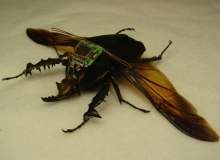
With modern threats such as terrorists and insurgents keen to blend into densely populated areas, a need for more covert surveillance techniques has emerged. Acknowledging the need for such watchful eyes, DARPA first sought proposals in 2005 and looked towards acquiring new technology capable of identifying and following high profile targets.
Micro Air Vehicles, or Nano Air Vehicles as they are sometimes referred to, could potentially offer those precise capabilities. A class of UAV restricted in size and designed to blend in with surroundings by acting in a similar fashion to life-like creatures, insect-sized MAVs are expected to be produced in the coming years.
Sought-after technology: DARPA’s plans for MAVs
The long list of capabilities associated with the development of such technology makes it easy to understand why DARPA has developed such a vaunted interest. The ability to remotely observe dangerous environments that are either inaccessible by traditional vehicles or require a less conspicuous, more covert approach could revolutionise intelligence-gathering from contested territories.

US Tariffs are shifting - will you react or anticipate?
Don’t let policy changes catch you off guard. Stay proactive with real-time data and expert analysis.
By GlobalDataThe US Army has made repeated inferences that trends associated with military action demonstrate conflicts are far more likely to take place in congested areas where collateral damage is more abundant, so the ability to act covertly will become almost a necessity.
The development of such vehicles has, however, ran into troublesome territory, owing to the current limits of technology. Nano Air Vehicles sought by DARPA are aimed at fitting within a specified size, with a wingspan limit of around 7.5cm. At this scale, teleoperation becomes impractical as the operator would be unable to see the object past 100m, leaving autonomy as the ideal flying practice for such a vehicle. Without a concerted agreement on the use of autonomous machines – detractors doubt their ability to determine between enemy and friendly forces – their use is likely to be strictly limited.
New technology hindered by familiar problems
Powering such machines is also likely to prove problematic. Battery technology is not yet advanced enough to offer the requisite size, weight and power parameters.
Batteries providing enough power to operate MAVs are too heavy, whereas the lighter versions would likely see the vehicle run flat before its return to base. Addressing this issue, designers have even considered a way in which an MAV could land on a power cable, leeching power from it in order to recharge mid-operation.
When posed with other operational problems – most notably how the characteristics of flight change significantly with smaller-scale vehicles – DARPA began to think outside of the box. Through a 2007 call, the organisation requested proposals relating to animal cyborgs – part animal, part robot – through which a live animal or insect could be equipped with a sensor suite and controlling mechanism before being guided towards a target area.
What could be described as a retrofit for nature, scientists and engineers have teamed up with biologists to test the installation of robotics on insects and animals. Beetles have emerged as a particular favourite given their impressive comparative strength, durability and flight capabilities.
Related content
Video feature: quadrotor claws, or grasping at straws?
Emerging technology has often taken inspiration from nature. Having previously sought bird-like UAVs with flappable wings, could the US Air Force’s next step be an eagle-inspired grasping claw?
Hail the HALE: renewed enthusiasm for HALE UAVs
Capable of soaring at high altitudes for days on end, high altitude long endurance (HALE) UAVs have emerged to an enthusiastic reception given their vaunted surveillance capabilities.


.gif)

